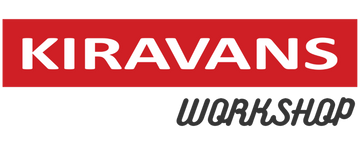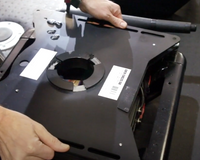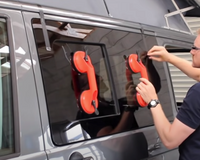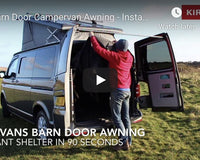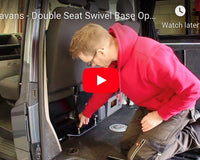Transcription de la vidéo
Maintenant, si je passe en revue cela du réservoir de carburant jusqu'au chauffage et ensuite dans le van, vous verrez le processus impliqué. Donc très rapidement, nous commençons par descendre le réservoir de carburant du van, retirer l'unité d'envoi, percer un petit trou dans le haut de l'unité d'envoi et y insérer ce tuyau de carburant. Maintenant, cela doit être coupé à la bonne longueur en fonction du type de véhicule dans lequel vous l'installez.
À partir de là, nous avons une ligne de carburant comme celle-ci, qui va ensuite au filtre à carburant et à la pompe à carburant, qui est suspendue au châssis du véhicule avec ce support à ressort en caoutchouc monté en caoutchouc. De la pompe à carburant, vous avez ensuite un peu plus de ligne de carburant, qui amène le carburant à l'unité de chauffage. Le carburant entre ici. Aussi en dessous, nous avons le câble électrique, qui alimente la pompe avec ce fil. Cette entrée ici est pour l'air frais pour la combustion dans l'unité, donc cela aspire l'air de l'extérieur du véhicule. Celui-ci est l'échappement. D'accord, donc cela va là et ensuite vous arrivez à votre chauffage réel. Une extrémité aspire l'air froid et l'autre extrémité souffle de l'air chaud et votre air chaud arrive à votre van par l'un de ces évents en plastique.
À l'intérieur du véhicule, vous avez votre faisceau de câblage qui prend l'alimentation de votre batterie de loisirs, se branche dans l'unité. Vous avez besoin de 12 volts électriques pour ces derniers pour allumer la flamme et ensuite pour faire fonctionner le ventilateur pendant qu'il fonctionne. Également incorporé dans cela est le panneau de contrôle numérique et le minuteur et spécifiquement pour ces kits, nous avons également cette belle fonctionnalité qui est un capteur de température qui peut être monté quelque part d'utile dans le véhicule afin que lorsque vous réglez votre thermostat, le chauffage.
Donc, cela ressemble à beaucoup de pièces, mais en fait, une fois que vous commencez, ce n'est pas trop mal. Vous obtenez également des instructions avec le kit et voyons comment il est installé. D'accord, donc c'est le véhicule dans lequel nous allons installer le chauffage aujourd'hui. C'est un modèle standard Volkswagen T5 2010 et il est vraiment important avant de commencer ce travail, assurez-vous que votre réservoir de diesel est assez vide. Donc celui-ci, le voyant s'est allumé pour dire qu'il est presque vide car lorsque vous abaissez ce réservoir numérique, s'il est plein de diesel, il est tout simplement trop lourd à manipuler physiquement.
La première étape pour installer l'un de ces chauffages est de faire descendre le réservoir de carburant du bas du van. Il est situé dans cette zone ici. Il y aura d'abord quelques panneaux en plastique à retirer, puis vous verrez le grand réservoir de carburant en plastique noir et il est maintenu par trois sangles métalliques. Six boulons doivent être retirés, puis vous descendez votre réservoir de carburant. Faites juste attention car il peut être lourd et vous pourriez mettre des blocs de bois ou quelque chose en dessous pour le soutenir.
Avant de descendre votre réservoir de carburant, vous devrez déconnecter ces deux tuyaux de diesel juste devant le réservoir et ensuite libérer votre tuyau de remplissage de carburant en dévissant la petite vis qui maintient le bouchon. Retirer le bouchon. Vous voudrez peut-être desserrer la petite porte métallique à ce stade, puis vous retirez la garniture en plastique en la poussant vers la droite en haut avant de la soulever par le bas. Enfin, dévissez cet écrou ici.
Cette partie ici s'appelle l'unité d'envoi. C'est un dispositif à ressort qui descend dans le réservoir de diesel et ensuite vos tuyaux de diesel sont ici et c'est un système sous pression. Donc, ce que nous devons faire, c'est déclipser ces deux lignes de carburant, dévisser cela et retirer l'unité d'envoi. Pour les déclipser, ils ont juste un petit onglet à l'arrière. Vous le poussez, il suffit de les déclipser comme ça. Pendant que j'étais sous le van, j'ai déconnecté la connexion électrique ici avec un petit onglet rouge, qui se soulève.
Maintenant, cet anneau de verrouillage qui maintient l'unité d'envoi dans le réservoir est vraiment serré, donc vous pouvez utiliser un morceau de bois et un marteau pour le desserrer comme ça. Une fois que vous avez retiré l'anneau de verrouillage, l'unité d'envoi se soulèvera un peu et vous devez simplement la retirer doucement. Faites attention de ne pas plier le flotteur de jauge de carburant, qui est sur un fil en bas. Vous le verrez lorsque vous arriverez à ce point. Donc, inclinez-le et retirez-le doucement. Maintenant, l'unité d'envoi sera pleine de diesel, donc ayez un seau prêt pour le vider.
Une fois que vous avez retiré l'unité d'envoi du van, nous devons percer un trou pour mettre le tuyau standard. Donc, si vous regardez en dessous, il y a un petit tuyau en plastique qui doit être percé et sur le dessus, il y a une empreinte carrée. Donc, au milieu de ce carré, j'ai mis un petit point et vous devrez utiliser un foret de six millimètres et percer à travers le haut de l'unité d'envoi, ce qui retirera le petit tuyau en plastique en dessous. C'est une bonne idée de faire une protection juste en dessous pour empêcher tout plastique d'entrer dans l'unité d'envoi. J'ai utilisé des serviettes en papier ici.
Une fois que vous avez percé votre trou en haut, vous devrez couper votre tuyau de carburant en métal à la bonne longueur et pour un van T5/T6, vous le voulez à 19 centimètres de long depuis le dessous de l'angle droit. Une scie à métaux tranchante le traversera assez bien et ensuite vous devrez ébavurer l'extrémité avec une lime en métal juste pour qu'aucune contamination ne s'y accroche une fois qu'il est dans le réservoir de carburant. Vous insérez le tuyau à travers le haut de votre unité d'envoi maintenant à travers votre nouveau trou. Mettez le petit écrou, assurez-vous que le joint torique est toujours en place en haut pour obtenir un bon joint et vous remarquerez que le tuyau descend derrière le tuyau à ressort translucide. Vous pouvez tout serrer avec quelques clés. Ensuite, la prochaine chose que vous devez faire est de prendre un des connecteurs de tuyau de carburant, de le mettre sur la buse en métal et avec un collier de serrage, serrez tout l'ensemble.
Maintenant, vous pouvez remettre l'unité d'envoi dans le réservoir de carburant. Encore une fois, faites attention avec le flotteur de jauge de carburant. Le joint en caoutchouc demande un peu de travail pour entrer, puis appuyez simplement sur l'unité en haut. Vous remarquerez qu'il y a deux flèches, une sur le réservoir et une sur l'unité d'envoi qui doivent s'aligner et c'est la position finale pour l'unité. Remettez l'anneau de verrouillage, vissez-le et utilisez à nouveau votre morceau de bois et un marteau pour le serrer complètement.
Ensuite, une fois que vous avez fait cela, il s'agit de prendre votre ligne de carburant et de la pousser bien dans le tuyau de connexion en caoutchouc et de la fixer avec un des colliers de serrage. Maintenant, vous pouvez reconnecter les deux tuyaux de diesel qui se remettent simplement sur l'unité d'envoi et toutes ces trois lignes de carburant peuvent maintenant être clipsées dans les clips en plastique qui sont déjà sur le côté du réservoir de carburant.
Ensuite, vous devrez attacher le filtre à carburant en ligne avec la pompe à carburant en utilisant les courtes longueurs de tuyau de carburant. Ils ont chacun une flèche pour montrer la direction du flux de carburant du réservoir au chauffage. Vous devrez également attacher le clip de pompe à carburant en caoutchouc comme ceci. Avec le réservoir de diesel remis sous votre van, vous devrez reconnecter ces deux tuyaux de diesel. Vous pouvez maintenant attacher l'ensemble filtre et pompe à carburant à ce support noir situé juste devant votre réservoir de carburant en utilisant la rondelle et l'écrou fournis. Connectez la ligne de carburant de l'unité d'envoi à l'extrémité du filtre et une autre longueur de ligne à l'extrémité de la pompe qui se dirigera vers l'autre côté du van. Remarquez la façon dont cet ensemble de pompe est légèrement incliné.
En passant maintenant du côté conducteur du véhicule, vous devez installer le tuyau d'entrée d'air froid en perçant un trou dans le seuil de porte et en installant la grille comme ceci. Vissez une longueur de conduit à l'arrière de la grille, puis passez-le à travers le trou dans la carrosserie du van. J'ai percé un trou légèrement plus grand dans la carrosserie que dans le seuil en plastique. Cela peut ensuite être fixé avec un collier de serrage à l'arrière.
Maintenant, c'est entièrement à vous de choisir où vous souhaitez avoir votre sortie d'air chaud dans le van, mais en réalité, il n'y a pas tant d'endroits où vous pouvez obtenir un dégagement pour percer à travers le sol du van et le faire sortir quelque part d'utile. Donc, j'ai opté pour une zone sous le siège du conducteur, puis une longueur de conduit allant à un panneau à l'arrière de la base du siège et sortant par une grille là-bas. Cette configuration me permet d'avoir suffisamment de place pour mettre une batterie de loisirs sous le siège du conducteur et le petit trou que vous pouvez voir dans le sol est celui qui est déjà là lorsque le van a quitté l'usine. Il est livré avec un passe-fil en caoutchouc et est vraiment utile pour faire passer les fils à travers le sol.
L'unité de chauffage elle-même reçoit d'abord ce petit joint en caoutchouc, donc passez le fil à travers, puis placez-le au bas du chauffage. Cela fournit un amortissement. Placez votre support en métal inoxydable orienté comme ceci, puis utilisez les rondelles et les écrous pour le fixer au chauffage. Maintenant, vous pouvez connecter votre entrée d'air froid pour la combustion en utilisant le collier de serrage et aussi votre tuyau d'échappement. Nous avons choisi de monter ce support en acier inoxydable sur le membre du châssis comme indiqué. Cela a impliqué de percer deux trous de sept millimètres et demi de diamètre, puis d'utiliser un taraud de huit millimètres pour créer un filetage. Nous avons ensuite utilisé nos boulons M8 avec des rondelles à ressort et du Loctite pour fixer la plaque de montage sous le van.
Le premier travail de câblage est simple. Il s'agit simplement d'utiliser le câble noir fourni pour prolonger le fil de l'unité de chauffage jusqu'à la pompe à carburant. Connecter le faisceau de câblage principal prend un peu plus de temps. La seule connexion sous le plancher du van est celle pour le connecteur du chauffage, qui se branche dans l'unité de chauffage principale. Tout le reste va au-dessus du plancher. Votre capteur de température à distance peut être monté quelque part dans le van qui est utile, généralement dans la moitié avant du véhicule en raison de la longueur du fil. Le positif et le négatif de la batterie vont évidemment à votre batterie de loisirs et votre panneau de contrôle peut être monté quelque part d'utile à l'arrière du van.
Lors du montage de cette unité de contrôle, vous devrez percer un trou assez grand pour faire passer les deux blocs de connexion en plastique et également mettre le support en caoutchouc à l'arrière de l'unité et le fixer avec une seule vis au milieu. D'accord, donc je suis juste sous le van, j'enregistre cela sur mon iPhone donc la qualité est un peu médiocre. Juste pour vous donner un aperçu rapide de l'installation du chauffage sous le van, c'est évidemment notre plaque de montage que nous avons vissée dans ce membre du châssis ici avec quelques boulons filetés. Nous avons taraudé les filetages, utilisé une rondelle à ressort et du Loctite et serré cela pour s'assurer qu'ils ne se détachent pas avec le temps. Notre chauffage est monté là-dessus.
Nous avons notre ligne de carburant qui arrive ici, qui part et j'ai remis certains de ces couvercles, mais elle part de l'autre côté du van vers la pompe. C'est notre prise d'air frais pour la combustion, que j'ai juste attachée avec un câble ici et laissée pointant vers le bas pour qu'aucune humidité ne puisse y pénétrer. Le tuyau d'échappement, je l'ai fait passer ici et percé un petit trou dans le van là-bas et mis un clip, un clip en métal pour le maintenir et j'ai coupé un trou dans le plateau en plastique pour qu'il puisse se remettre en place. Ne laissez pas cela toucher quoi que ce soit car cela va devenir très chaud lorsque le chauffage brûle.
C'est notre tuyau qui monte à travers le bas du van, sort sous le siège du conducteur et notre câblage, c'est notre fil principal qui sort du chauffage. Il passe par ici. Je l'ai juste attaché avec des câbles. Il y avait pas mal de surplus, donc je l'ai mis là-haut, attaché avec des câbles en place. Ensuite, celui-ci passe et monte à travers ce passe-fil sous le siège du conducteur jusqu'à la batterie et au panneau de contrôle. Il y a un autre fil ici qui va à la pompe à carburant.
Donc, c'est essentiellement tout pour l'installation sous le van. Juste avant de passer au test du système, il y avait une partie que j'ai survolée et c'était la connexion de cette ligne de carburant de la pompe à carburant à travers et sous le van et la connexion à l'unité de chauffage avec une autre courte longueur de tuyau de carburant. Une fois que vous avez tout connecté, vous pouvez tester votre système en appuyant sur le bouton sur le côté droit du contrôleur une ou deux fois, puis en augmentant la température thermostatique à un niveau souhaité. Après quelques secondes, vous entendrez l'unité démarrer et elle tentera de commencer à aspirer du diesel à travers le système. Vous devrez passer par ce processus trois ou quatre fois. Vous pouvez accélérer le processus d'arrêt en retirant le fusible, puis en le remettant, et après trois ou quatre fois, vous devriez constater qu'il s'allume réellement et commence à produire de la chaleur. Le temps pris est vraiment juste pour faire passer le diesel à travers le système.
